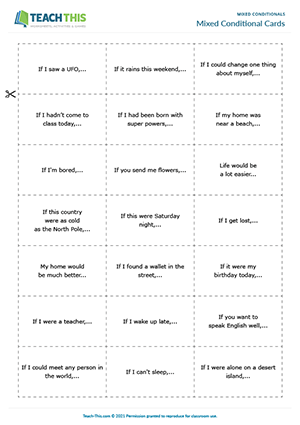Conditional Clauses Speaking Activities For Preschoolers
понедельник 18 февраля admin 49
Moral Dilemmas Second conditionals are used in real life to talk about questions like “What would you do if you had to choose between letting a war criminal go free so that he’d stop the war and continuing the war until he could be brought to justice?” Giving students a few questions like this to discuss can be intellectually stimulating and produce a good mix of the second conditional and other language. It can also be designed to fit in with the topics of the book (e.g. Environmental moral dilemmas) or with their job or studies (e.g. Medical moral dilemmas). They can also make up similar questions to ask each other.
Oct 7, 2016 - And you can get your students speaking just as many by using pictures. Can your students think of 3 Second Conditional sentences in. To vairy your teaching methods so that the children get easily involved into the lesson. These clauses are the endings of a first conditional sentence. The teacher reads out the beginning of each clause and the pairs must cross off the ending they think is correct. The pair that crosses all clauses off shouts Bingo. They then read back their clauses to make sure they’re right.
Guess My Answer The Moral Dilemmas activity above can be made more fun by getting students to guess their partners’ answers before they ask the questions. This also works for other meanings of the second conditional such as tentative offers in negotiations. Give students a list of deals such as “If I gave you 1,000 pounds, would you do my washing up for a month?” and get them to guess what their partners will say before they ask the question. They can then make up similar sentences specifically to elicit a particular response, e.g. “Would you give me your wife if I gave you my bicycle?” to obtain a “No, I wouldn’t.” 3. Sentence Completion Give students at least fifteen second conditional sentence starters such as “If I had four legs” or “If I were the richest person in the world”.
They should complete the sentences with their own ideas and then read out just the part they have written (not the sentence stems on the worksheet) for their partners to guess which sentence they wrote it in, e.g. “People would take photos of me all the time” could be written in either of those two example sentence stems above. The sentence stems could also be moral dilemmas, or you could write them to tie the second conditional in with other language points such as feelings (“I would feel _______ if the internet disappeared”) or phrasal verbs (“If _______, I would get on much better with him/her”). Problem Solving Problems like being stuck on a desert island or having a can of food but no can opener are often used in ELT for practice of “going to” for plans. Film metal fight beyblade sub indonesia. However, as the students are not really in that situation it is much more natural to ask “What would you do if flood waters cut your house off?” and “What would you do if all electronic communication permanently broke down?” People can then debate which idea is best and/or vote on the best idea.

Votes Voting can also be used in other ways to practise the second conditional. For example, people can present their ideas on what they would do if they were put in charge of the world or if they were given superpowers, and then people can vote for the best. The ideas need to be quite outlandish ones like these, because otherwise the first conditional is a more natural tense to use to present your ideas.
